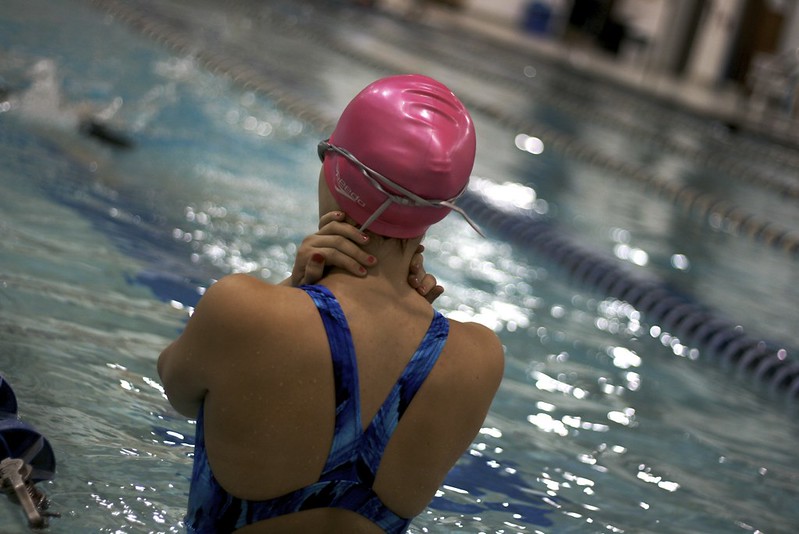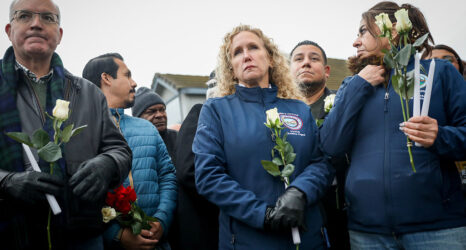
The following is an excerpt from “Misplaced Faith” in the Fall 2014 issue of Ms. Read the whole article by getting a digital subscription to the magazine.
She is special.
That’s what club swim coach Norm Havercroft in Saratoga, California, told the mother of 15-year-old competitive swimmer Jancy Thompson in 1997. And because she was so special, Havercroft needed to spend one-on-one time with her every morning, at 5 a.m. So the mother, who also had an infant son, got up before dawn to drive her daughter to the pool and wait in the parking lot, breastfeeding the baby.
But, according to the allegations of Thompson’s 2010 lawsuit, the coach wasn’t giving her training tips. Before the rest of the team arrived for practice, Thompson claimed, Havercroft allegedly was taking her into a private room and molesting her.
Havercroft was accused of molesting at least one other young girl, but was never convicted and kept coaching for years despite the revelations, denying all charges. But there’s a growing Hall of Infamy among U.S. swim coaches who were convicted of sexual abuse—including Andy King (serving 40 years in prison), Rick Curl (serving seven years) and Brian Hindson (serving 33 years for secretly videotaping female swimmers in their locker room). There are now at least 68 coaches and swimming officials “banned for life” from USA Swimming for sexual abuse or misconduct.
The problem isn’t just what coaches have done to underage athletes, but the fact that national sports governing bodies (NGBs) such as USA Swimming—which boasts 400,000 athlete members—didn’t take swift actions to protect vulnerable young competitors from such predators. Even when coaches would leave a swim club because of abuse allegations, there was no warning from USA Swimming to other clubs or to swimmers’ parents about the coaches’ behavior when they moved on to a new locale and new victims.
“The thinking was to keep it very quiet,” says Nancy Hogshead-Makar, who won three gold medals at the 1984 Olympic Games. “They were afraid of defamation lawsuits. When they knew about somebody who was a sexual abuser, it wasn’t [the NGB’s] responsibility—it was society’s responsibility, it was the police’s responsibility, it was the parents’ responsibility, it was the club’s responsibility.”
Sounds like the Catholic Church hierarchy. Indeed, over the past decade, sexual-abuse scandals have emerged in a number of corners of American culture—from the priesthood to the military to college campuses. It’s not that those abuses hadn’t been going on for decades, or even centuries, but survivors have typically been scared or shamed into silence. No more. One of the latest actions taken by abuse survivors from the swimming world was to challenge the induction of longtime USA Swimming executive director Chuck Wielgus into the International Swimming Hall of Fame. Nineteen victims of coaching sexual abuse—including Cuba-to-U.S. marathon swimmer Diana Nyad (who has alleged that her coach Jack Nelson molested her 50 years ago)—signed a petition pointing out Wielgus’ longtime inaction against abusive coaches.
In early June, Wielgus withdrew his nomination from the Hall of Fame and offered a blogged apology for not having done more to prevent sexual abuse, admitting that he should have said “I’m sorry” four years earlier when he was interviewed by ABC’s 20/20 for the newsmagazine’s exposé of abusive swim coaches. When he finally did apologize, he pleaded ignorance about issues of sexual abuse prior to 2010—much like those in the Catholic Church hierarchy have done.
“Too little, too late and forced,” said attorneys Robert Allard and Jon Little. Allard, who’s based in San Jose, California, has become the go-to barrister for athletes who were abused (he has sometimes partnered with Indianapolis-based Little). He remembers clearly his first contact with a parent looking for representation: The caller’s 12-year-old daughter, training under Andy King at San Jose Aquatics, had been isolated in a shack-like facility adjoining the pool so that King could supposedly massage her shoulder. Before long he was taking off her top and massaging her breasts as well.
Since the call about King, more than 100 women have dialed Allard’s number—often women in their 30s, 40s and 50s. Hogshead-Makar, currently senior director of advocacy for the Women’s Sports Foundation, explains why reporting may take so long: “Right about when [women] either have kids that are the age they were when they were molested, or they hit 40…that’s when they ‘find their mojo’ and realize that the coach is still on the [pool] deck. But by that time, there is no remedy from the police [because the statute of limitations has expired].”
Swimming isn’t the only sport with abusive coaches, of course. And swimming also isn’t the only Olympic sport in which women (and men) have been moved to activism. This year, 66 speed skaters petitioned U.S. Speedskating to remove former Olympian Andy Gabel from the sport’s national Hall of Fame and give him a lifetime ban. Gabel was accused in 2013 by speed skater Bridie Farrell of sexual misconduct with her in Saratoga Springs, New York, around 1997 and ’98, when she was 15 (Gabel was 33, her teammate and mentor).
If women or male athletes are sexually abused by a high school or collegiate coach, they would at least be able to use Title IX to sue for sex discrimination. But extracurricular sports clubs and the national Olympic program aren’t covered by that federal law. The Women’s Sports Foundation and others have been lobbying for several years to at least create a body independent of the clubs and NGBs that could deal with complaints of sexual abuse—and that is finally close to fruition.
In early June, the U.S. Olympic Committee voted to form such an entity—to open next year—starting with a $5.2 million investment, and plans to raise another $15 million. It would be similar to USADA—the U.S. Anti-Doping Agency—which is an independent nonprofit that handles drug testing of athletes (and subsequent punishments of rule offenders, such as cyclist Lance Armstrong).
After the revelations and bad publicity generated by the 20/20 report, USA Swimming did begin to clean up its act. It developed a Safe Sport program, complete with a code of conduct that strongly encourages reporting improper behavior. But despite good intentions, Allard questions the leadership of the antiabuse program. “I think Safe Sport is a joke,” he says, calling its leader, Susan Woessner, a “company person.” The program, he says, needs a leader who acts autonomously and puts the welfare of children over image and corporate sponsors.
Legislators have also stepped in. In 2012, Rep. George Miller (D-Calif.) asked the Government Accountability Office (GAO) to investigate whether existing laws and policies are adequate to prevent abuse of students. In June, Pennsylvania Gov. Tom Corbett signed into law HB 112, which created the new felony crime of sexual assault by a sports official—including coaches, trainers and team managers—against a child under 18 who participates in a sports program.
Athletes in California haven’t been so successful in finding legal redress for sexual assaults. Last October, California Gov. Jerry Brown (D) vetoed Senate Bill 131, which would have opened a yearlong window for sex-abuse survivors to file suit, even though their cases had passed the statute of limitations. Said Brown in his veto message,
There comes a time when … past acts are indeed in the past and not subject to further lawsuits. With the passage of time, evidence may be lost or disposed of, memories fade, and witnesses move away or die.
Tell that to the sexual-abuse survivor for whom the past is always present. For whom the memories have sharpened rather than faded. For whom the chance to finally be a witness would, at this point, be almost as triumphant as an Olympic medal.
Read the rest of the article by getting a digital subscription to Ms.
Photo from Flickr user MissMessie under license from Creative Commons 2.0
Michele Kort is senior editor of Ms.





